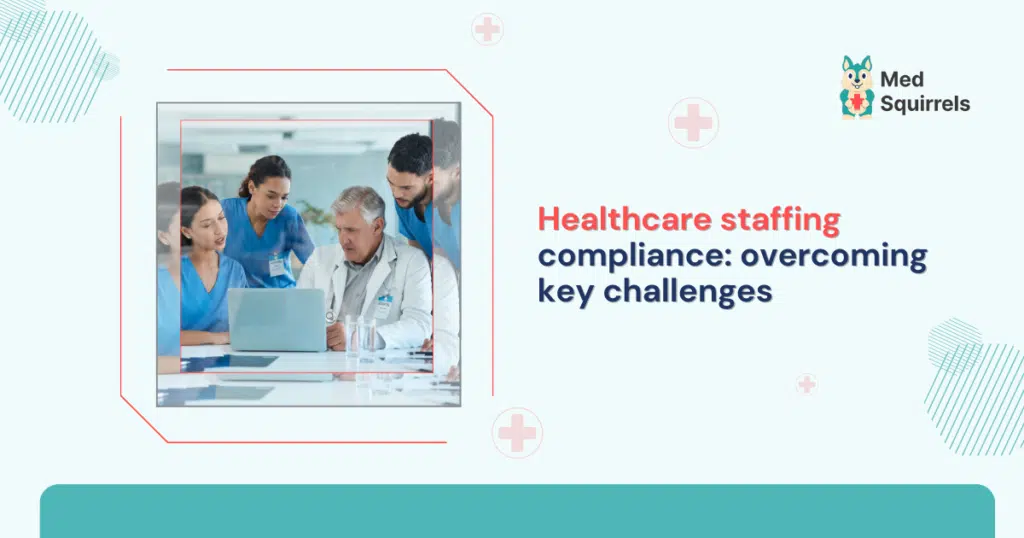Healthcare staffing compliance: overcoming key challenges

Healthcare staffing is a multifaceted process affected by many regulations at the federal and state levels. Regulations impact healthcare staffing in hiring practices, employee training, patient care quality, and operational effectiveness. These regulations dictate the qualifications required for various positions and influence the overall culture within healthcare organizations. Compliance with hiring regulations ensures adherence to standards but also challenges healthcare facilities to maintain an adequately staffed and effective workforce.
Familiarity with these rules is key to effective decision-making on staffing following legal and ethical procedures. Adapting to these regulations requires proactive planning and continuous evaluation of staffing strategies. A well-informed approach can help healthcare facilities balance regulatory compliance with operational success. Moreover, ongoing training and support for staff can enhance understanding and implementation of these regulations. Collaboration between policymakers and healthcare organizations is vital to creating practical, effective staffing solutions, considering the impact of regulations on healthcare staffing.
Understanding healthcare employment laws
Healthcare employment laws establish guidelines for hiring, workplace conditions, and employee rights. Laws such as the Fair Labor Standards Act (FLSA) and the Family and Medical Leave Act (FMLA) impact wage regulations, working hours, and leave policies in the healthcare sector. Additionally, compliance with the Americans with Disabilities Act (ADA) ensures equal employment opportunities for individuals with disabilities in healthcare roles.
The Occupational Safety and Health Administration (OSHA) also enforces workplace safety regulations, significantly affecting staffing requirements. Employers must ensure that healthcare workers have a safe environment, proper training, and appropriate equipment to prevent workplace hazards, reflecting the broader impact of regulations on healthcare staffing.
Failure to comply with these regulations can lead to penalties, legal disputes, and reputational damage. Healthcare facilities must stay updated with evolving healthcare hiring regulations to create fair and compliant workplaces. The www.uschamber.com provides more details on these laws.

State regulations for healthcare workers: a look at key differences
State regulations for healthcare workers differ significantly, impacting licensing, certification, and staffing mandates. Some states have strict staffing regulations to ensure high levels of patient care, while others allow greater flexibility in workforce management, highlighting the impact of regulations on healthcare staffing. These variations can lead to disparities in the quality of care provided to patients across different regions. Consequently, healthcare facilities must navigate these complexities to maintain compliance and optimize their workforce.
Example 1: California’s nurse-to-patient ratio law
In California, state law requires minimum nurse-to-patient ratios in hospitals so that each nurse sees a restricted number of patients to ensure safety and quality of care. For example, California Assembly Bill 394 dictates one nurse for every five in medical-surgical units and one nurse for each two in intensive care units. Although this measure improves patient results, it will also boost hiring demands by necessitating hospitals to hire extra qualified nurses so that they achieve legal requirements.
Example 2: Texas’ flexible staffing laws
Conversely, Texas has less stringent staffing laws, with greater freedom given to healthcare facilities to manage their workforces. Hospitals must provide quality patient care but are not subject to definite nurse-to-patient ratio statutes. So, they can change staff levels depending on operational demands and patient loads. This enables them to exercise control over costs but may result in inconsistencies in patient care quality across various facilities. The Texas Health and Human Services Commission (HHSC) oversees these regulations, which can be explored further on their official website.
These differences highlight how state regulations for healthcare workers vary, requiring healthcare providers to tailor their staffing strategies based on local compliance requirements.
Meeting staffing standards: rural & urban facilities compared

Source:KFF Issue Brief
HIPAA compliance in hiring
Maintaining patient confidentiality is an essential element of healthcare compliance when hiring. The Health Insurance Portability and Accountability Act (HIPAA) requires healthcare organizations to protect sensitive patient information, even when hiring. Employers should ensure that background checks, interviews, and credential verifications do not violate patient confidentiality.
To meet HIPAA compliance in hiring, healthcare employers ought to:
- Utilize secure background screening platforms to safeguard candidate information.
- Educate HR staff on HIPAA privacy and security regulations.
- Ensure confidentiality and security in all hiring communication.
Non-adherence to HIPAA compliance in hiring will attract serious sanctions and a loss of patient trust. Healthcare providers must use secure data handling procedures and adopt hiring systems where confidentiality is the priority.
Ensuring compliance in healthcare hiring: key requirements
Ensuring healthcare compliance in hiring goes beyond HIPAA and extends to background checks, professional licensing, and workforce diversity regulations. Healthcare facilities must verify qualifications and credentials to ensure staff members meet industry standards, further demonstrating the impact of regulations on healthcare staffing.
Key aspects of healthcare hiring regulations include:
- Conducting thorough background checks to prevent hiring unqualified professionals
- Verifying certifications and licensure following state regulations for healthcare workers.
- Maintaining equal employment opportunities to comply with healthcare employment laws.
- Implementing ongoing training programs to ensure compliance with updated regulations.
Healthcare organizations can mitigate risks and build a reliable workforce by following these compliance measures. The Centers for Medicare & Medicaid Services(CMS) also provides important hiring and compliance guidelines, which can be explored on their official website.
Essential hiring regulations in healthcare: compliance checklist
Healthcare recruitment is governed by strict laws that affect recruitment practices. Some of the common laws are:
- The Joint Commission standards – Require healthcare organizations to follow strict hiring, training, and credentialing protocols.
- OSHA regulations – Ensure workplace safety by enforcing policies that protect healthcare workers from occupational hazards.
- Equal Employment Opportunity (EEO) laws – Prevent discrimination in hiring practices and promote diversity in healthcare workplaces.
Failing to comply with these healthcare employment laws can result in fines, lawsuits, and reputational damage.
The problems with traditional staffing & how MedSquirrels can help overcome them
Traditional healthcare staffing methods rely heavily on agencies that charge high commissions, create inefficiencies, and provide limited transparency. These challenges lead to:
- High costs due to agency markups and hidden fees
- Longer hiring timelines caused by outdated recruitment processes
- Compliance risks stemming from improper credential verification
MedSquirrels revolutionizes healthcare staffing by offering a flat-fee pricing model that eliminates exorbitant agency markups, providing a cost-effective alternative to traditional staffing agencies and Managed Service Provider (MSP) models. Unlike the traditional MSP approach, which often involves complex vendor management and variable costs, MedSquirrels simplifies the process with transparent pricing and streamlines through its plans, which include Orange Plan, Purple Plan, and Blue Plan options suitable to meet diverse facility needs.
MedSquirrels, with its innovative platform, also supports contractual staffing, allowing healthcare facilities to hire professionals flexibly based on their needs while ensuring compliance with healthcare hiring regulations. Unique features of the MedSquirrels portal, such as automated credentialing, AI-driven job matching, and real-time shift management, enhance efficiency and address the impact of regulations on healthcare staffing. By aligning with state regulations for healthcare workers and prioritizing healthcare compliance in hiring, MedSquirrels empowers healthcare facilities to build a sustainable, well-staffed workforce. Discover how MedSquirrels works and transform your hiring process. Get a demo of our staffing platform to know more!
FAQs:
How do healthcare regulations impact staffing decisions?
Healthcare regulations affect staffing by enforcing licensing, credentialing, and workplace safety requirements. Facilities must comply with healthcare hiring regulations to ensure quality patient care while managing staffing shortages and compliance costs.
What are some key healthcare employment laws?
Major healthcare employment laws include the Fair Labor Standards Act (FLSA), Americans with Disabilities Act (ADA), and Family and Medical Leave Act (FMLA). These laws regulate wages, workplace safety, and equal employment opportunities.
What are common OSHA violations in healthcare staffing?
Common OSHA violations include lack of PPE, improper patient handling, inadequate infection control measures, and failure to train staff on safety protocols. Non-compliance can lead to fines and legal action.
How does MedSquirrels simplify compliance with healthcare hiring regulations?
MedSquirrels automates credential verification, background checks, and compliance tracking, ensuring healthcare facilities easily meet hiring regulations.
How does MedSquirrels support healthcare organizations facing staffing shortages?
MedSquirrels provides an AI-driven job-matching system to assist healthcare facilities in finding qualified professionals faster, ensuring regulatory compliance.
